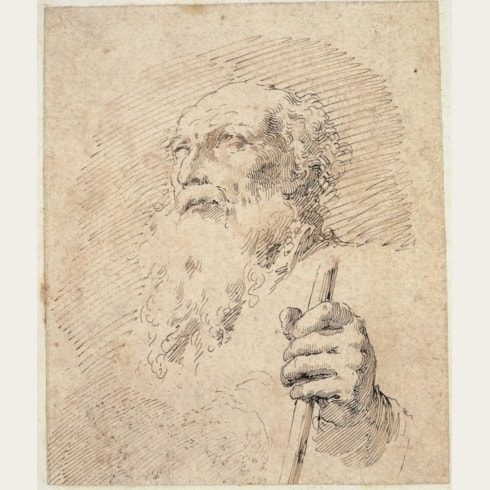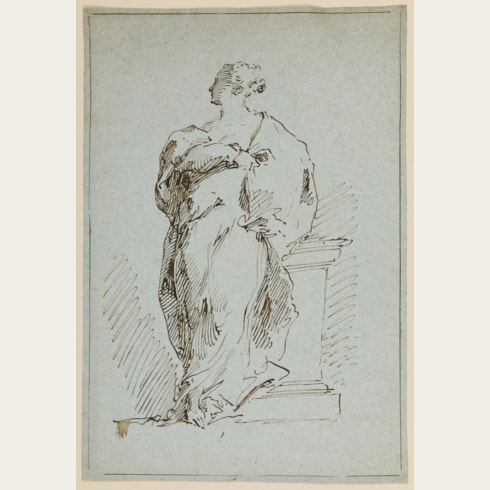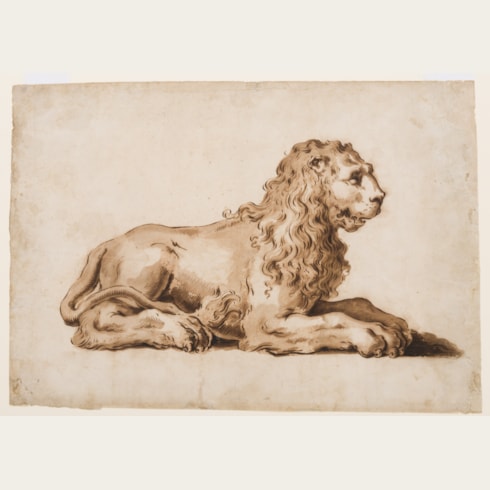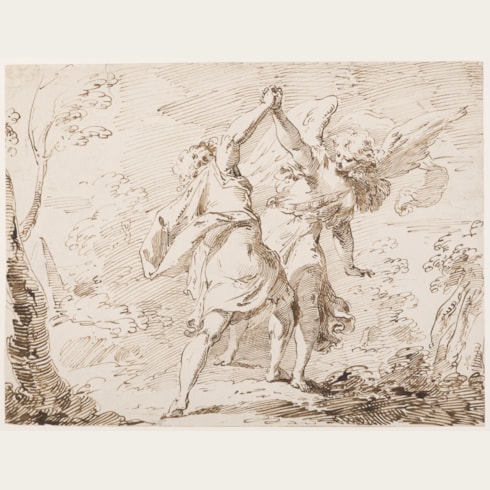Pietro Antonio NOVELLI
(Venice 1729 - Venice 1804)
Two Telamons
Pen and black ink and black and grey wash, heightened with white on paper washed ochre.
Inscribed David. at the lower left.
273 x 195 mm. (10 3/4 x 7 5/8 in.)
Inscribed David. at the lower left.
273 x 195 mm. (10 3/4 x 7 5/8 in.)
This drawing belongs with a small but distinctive group of similar figure studies, executed in black and grey ink on prepared paper, some of which are either derived from, or inspired by, sculptural models. These drawings have borne different attributions in the past, but are now generally given to Novelli. Five drawings from this homogenous group are today in the Ecole des Beaux-Arts in Paris, while three sheets are in both the Metropolitan Museum of Art in New York and the Musée des Beaux-Arts in Orléans, and one is in the Ashmolean Museum in Oxford. A closely-related pair of drawings of telamons appeared at auction in Monaco in 1984.
Several other examples of drawings by Novelli in this idiosyncratic technique are in the Harvard University Art Museums in Cambridge, Massachusetts and the Cooper-Hewitt Museum in New York, while a stylistic comparison may also be made with a Neptune formerly in a private collection in Brussels and a Standing Apostle at one time in the collection of Adolphe Stein in Paris.
The inscription ‘David’ at the lower left of the present sheet, which appears to be in the same black ink as that used in the drawing itself, raises the intriguing possibility that this drawing, and by extension others of this group, may be the work of Novelli’s younger contemporary, the Genoese artist Giovanni David (1743-1790). Certainly, the draughtsmanship of this group is somewhat looser and more painterly than in most other drawings by Novelli, which has been explained by the proposal that the drawings date to an early phase in his career. It is, nevertheless, possible to detect a Genoese flavour in these studies that suggests that they may be the work of a different artist altogether. The fact that the inscription on the present sheet seems to resemble a signature found on an autograph drawing by Giovanni David, dated 1778, in the Ecole des Beaux-Arts in Paris, likewise implies that the attribution of this interesting group of drawings to Novelli may need to be further studied.
Several other examples of drawings by Novelli in this idiosyncratic technique are in the Harvard University Art Museums in Cambridge, Massachusetts and the Cooper-Hewitt Museum in New York, while a stylistic comparison may also be made with a Neptune formerly in a private collection in Brussels and a Standing Apostle at one time in the collection of Adolphe Stein in Paris.
The inscription ‘David’ at the lower left of the present sheet, which appears to be in the same black ink as that used in the drawing itself, raises the intriguing possibility that this drawing, and by extension others of this group, may be the work of Novelli’s younger contemporary, the Genoese artist Giovanni David (1743-1790). Certainly, the draughtsmanship of this group is somewhat looser and more painterly than in most other drawings by Novelli, which has been explained by the proposal that the drawings date to an early phase in his career. It is, nevertheless, possible to detect a Genoese flavour in these studies that suggests that they may be the work of a different artist altogether. The fact that the inscription on the present sheet seems to resemble a signature found on an autograph drawing by Giovanni David, dated 1778, in the Ecole des Beaux-Arts in Paris, likewise implies that the attribution of this interesting group of drawings to Novelli may need to be further studied.
The outlines of Pietro Antonio Novelli’s long career are known through his posthumously published memoirs, which appeared thirty years after his death. Trained in the studio of Giambattista Pittoni, he also came under the influence of Gaspare Diziani and Francesco Guardi, while his earliest paintings – a Saint Joseph in the Venetian church of Santa Fosca and a Presentation in the Temple in the church of San Francesco in Rovigo, both painted in 1759 – show the influence of Jacopo Amigoni. Among other early documented works are a set of illustrations for an edition of Torquato Tasso’s Gerusalemme Liberata, published in 1760, and several plates for the complete edition of Carlo Goldoni’s Commedie, published in 1761 and 1788. In 1768 Novelli was accepted as a member of the Accademia in Venice, for whom he submitted an Allegory of the Arts as a reception piece.
Novelli painted frescoes in several Venetian palaces, including that of the Corniani-Tivan, Mangilli, Mocenigo and Sangiatoffetti families, and also painted altarpieces and decorative frescoes throughout Northern Italy; in Udine, Padua and Bologna, as well as in Venice. Indeed, ‘Novelli was one of the most active participants in the great wave of decorative painting that swept Venice and the Veneto in the last thirty years of the Venetian republic.’ Among the artist’s patrons was Catherine the Great, Empress of Russia, for whom in 1772 he painted a mythological composition as a pendant to a work by Pompeo Batoni. By 1779 Novelli had settled in Rome, where he worked for most of the next twenty years, and where he came under the influence of Neoclassicism and such artists as Batoni and Anton Raphael Mengs. During his years in Rome he completed a ceiling painting of Cupid and Psyche for the Villa Borghese and received commissions for the decoration of several Roman palaces. The last years of his career were spent in Venice. His son Francesco Novelli followed in his father’s footsteps as an engraver and designer of prints and book illustrations.
Novelli is best known today for his drawings. He was an inventive and versatile draughtsman, and, as one contemporary source noted, ‘The drawings and painted works by Novelli showed not just a profound knowledge, but also a supreme degree of fantasy, and I myself saw him change in ten and more ways the same subject.’ His many and varied drawings – executed in both pen and ink and watercolour and, more rarely, in red chalk - include studies for paintings and altarpieces, as well as a significant number of designs for book illustrations, prints and frontispieces. Large groups of Novelli’s lively and colourful drawings are today in the collections of the Museo Correr in Venice, the Ecole des Beaux-Arts in Paris, the Cooper-Hewitt National Design Museum in New York and the Albertina in Vienna.
As one scholar has noted of Novelli, ‘He was an extremely versatile artist, drawing on Venetian, Bolognese and Roman traditions in his altarpieces and frescoes. However, Novelli is at his most impressive as a draughtsman, whether working economically with the pen…or delicately brushing on complementary shades of wash…With his multifarious talents, Novelli could well be regarded as the Palma Giovane of his time - both artists worked in Rome and Venice and attempted to combine the virtues of academic classicism with Venetian painterliness; Palma and Novelli were prolific draughtsmen, and both had to live with the achievements of far greater artists in view.’
Provenance
Anonymous sale, Florence, Casa d’Aste Pitti, 14 May 1987, lot 1108 (as Attributed to Novelli)
P. & D. Colnaghi, London, in 1995
Private collection.
P. & D. Colnaghi, London, in 1995
Private collection.









